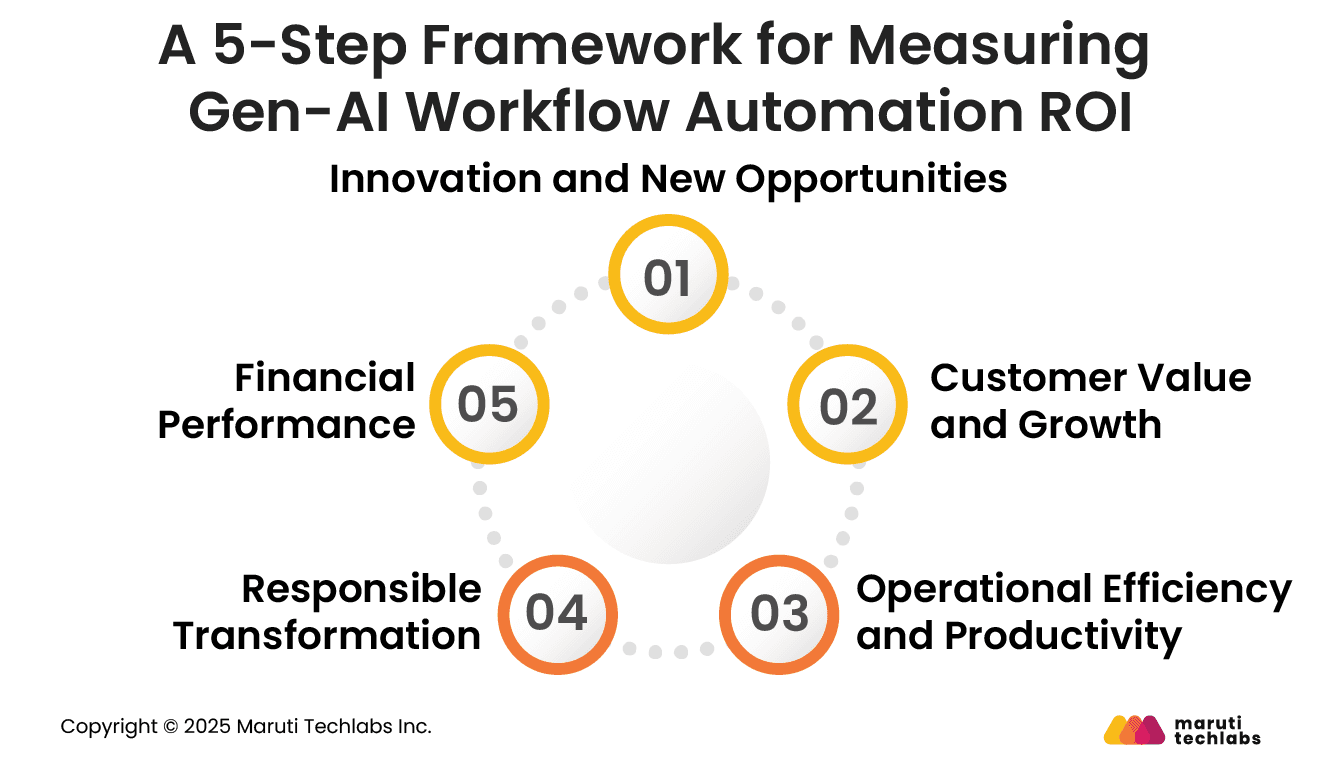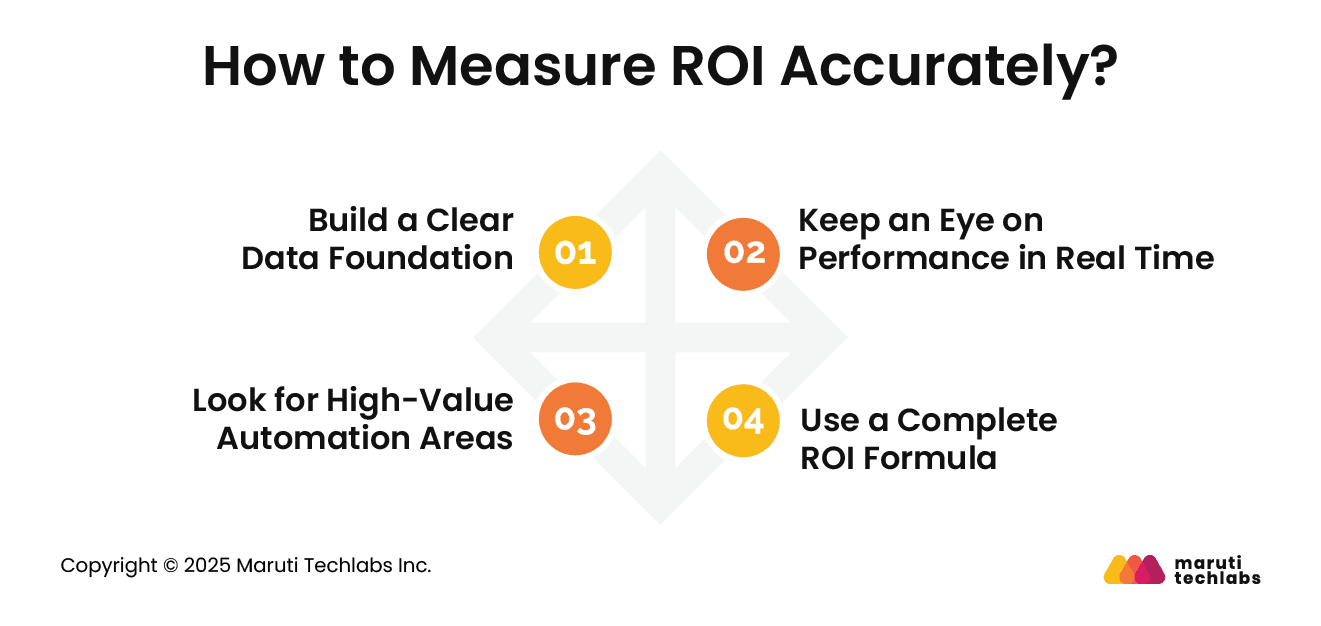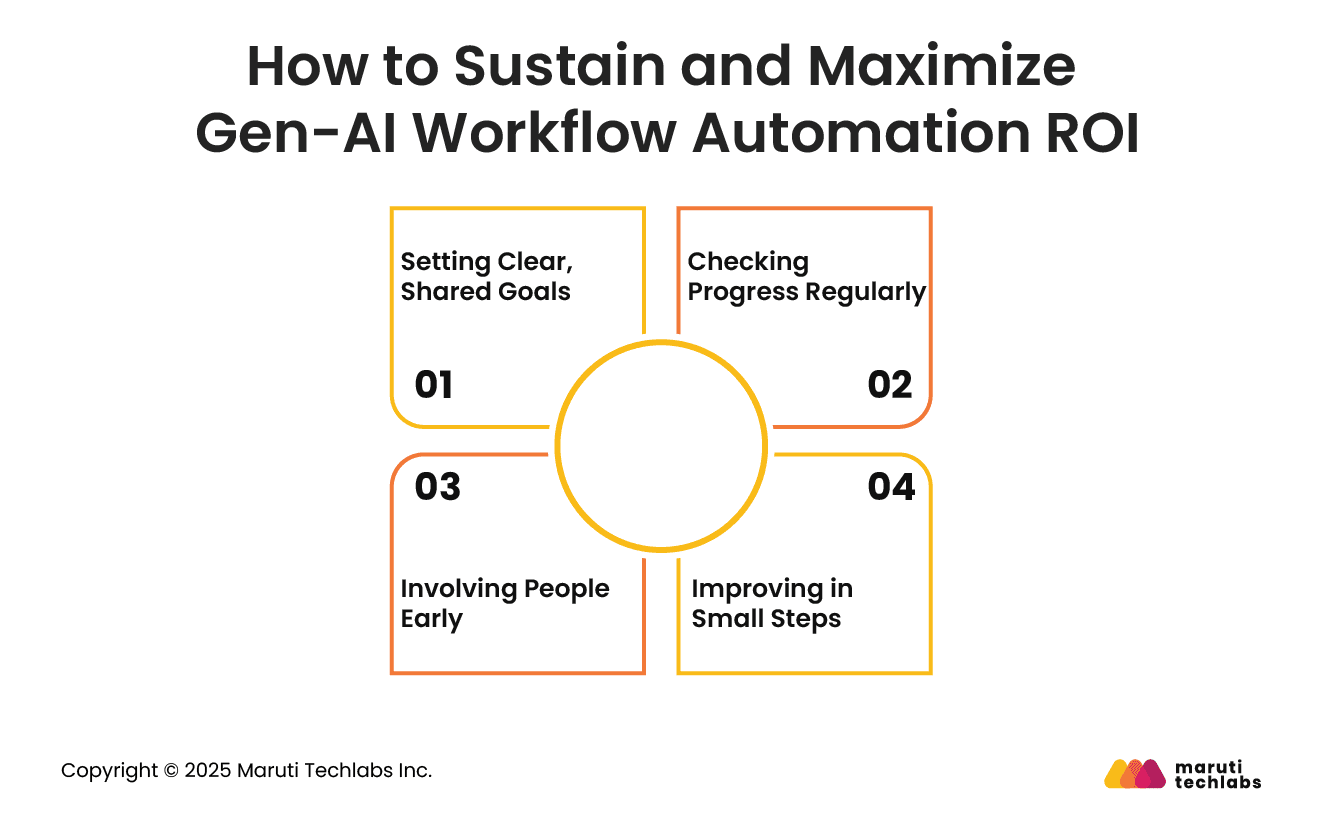

How to Prove Real ROI from Gen-AI Workflow Automation






Generative AI has quickly entered the mainstream. In 2023, only about one-third of companies were using it. By 2024, that number had climbed to nearly three-quarters. With this AI boom, more teams are investing in AI automation workflow projects to cut manual work, speed up tasks, and make everyday operations smoother.
But even with all this progress, many companies still aren’t sure what they’re actually getting in return. Gartner says that global spending on generative AI is expected to hit $644 billion in 2025, yet many projects never make it past the pilot phase. It is now essential for leaders to establish that these projects generate meaningful value and are not driven purely by industry momentum.
A McKinsey survey also found that fewer than 20% of companies set appropriate KPIs for their generative AI projects. Without clear metrics, it becomes difficult to understand whether AI is truly making a meaningful impact on the business.
This blog focuses on helping organizations measure that impact with clarity. It explains what Gen-AI workflow automation is, the core technologies behind it, and why ROI is often challenging to assess. It also outlines a simple, 5-step framework to measure ROI, how to track it accurately, and how to sustain long-term value from AI automation workflows.
Gen-AI workflow automation uses generative AI to make everyday work easier. It helps teams cut down on manual tasks, speed up routine work, and make better decisions with the information they already have.
Unlike traditional automation, which only follows strict rules, Gen-AI can understand context, handle unstructured or messy data, and learn from patterns as it works. This makes it useful for many real-world tasks that change often or require some level of reasoning instead of just step-by-step instructions.
In simple terms, Gen-AI workflow automation helps businesses run smoothly. It speeds up work, cuts down repetitive tasks, and allows teams to focus on more meaningful activities. It also supports growth by connecting different tools and systems so processes can run end-to-end with less human intervention.
Whether it is drafting emails, summarizing long documents, extracting information, answering customer questions, or coordinating multi-step tasks, Gen-AI can fit into existing workflows and improve them without completely rebuilding how things work.
To make all this possible, Gen-AI workflow automation relies on a set of core technologies that work together behind the scenes:

Together, these technologies form the foundation of Gen-AI workflow automation, making it possible to build smarter, more adaptive workflows across the organization.
Measuring the ROI of Gen-AI and AI automation workflow systems is not simple. Several practical issues can affect performance, cost, and long-term value. The main challenges include the following:

Poor data quality is one of the biggest barriers to accurate ROI measurement. Gen-AI models depend on clean and consistent data, and results drop when the data is messy or outdated. On top of that, the technical work needed to build, train, and deploy Gen-AI models is often more complex than teams expect.
Most Gen-AI workflows need fine-tuning, prompt adjustments, and other custom changes to fit real business needs. These efforts add unexpected costs, which makes it harder to assess true ROI.
Many organizations do not have enough skilled Gen-AI talent, leading to extra spending on hiring or external support. Governance issues also make ROI unclear. AI models lose accuracy over time if they are not monitored and refreshed, and stale data can reduce the value of AI automation workflow outcomes.
Gen-AI automation requires continuous updates, monitoring, and retraining. These ongoing needs increase long-term costs, yet they are often left out of early ROI calculations.
When Gen-AI solutions are deployed in isolated teams or departments, it becomes difficult to measure the full business impact. Siloed setups also create duplicate efforts and hide the true enterprise-wide ROI.
Measuring the ROI of Gen-AI workflow automation works best when you look beyond just cost savings. A simple way to do this is by evaluating value across five key areas. This helps teams understand both the early signs of progress and the long-term business impact of AI automation workflow initiatives.

Gen-AI helps teams test ideas quickly and work in new ways. You can measure this by looking at how many experiments happen, how fast prototypes are built, and what new opportunities emerge. Even if revenue takes time, these early signals show that innovation is moving in the right direction.
This pillar measures how Gen-AI improves customer experience. It focuses on whether AI-driven tools lead to better satisfaction, faster support, or more personalized interactions. Useful metrics for AI-driven campaigns include CSAT, NPS, customer lifetime value, and conversion rates. Happier customers often lead to higher retention and long-term growth.
For many businesses, this is where ROI becomes visible early. Gen-AI reduces manual work, speeds up execution, and improves accuracy. Time savings, fewer errors, and higher productivity are the key signals.
For instance, if a Gen-AI tool automates 70 percent of a manual task, the hours saved directly contribute to productivity gains.
AI should be adopted responsibly. This category focuses on risk, compliance, and employee readiness. Metrics include compliance checks, reduction in AI errors, and the percentage of employees trained on AI tools. Strong governance protects long-term value and ensures smooth adoption.
Finally, this pillar captures direct financial results. This includes revenue influenced by AI, cost reductions, improved margins, and shorter payback periods. These indicators may emerge later, yet they reveal whether the early efficiency gains are turning into actual financial outcomes.
This five-step framework helps companies track Gen-AI’s value more clearly and build confidence in their AI investments.
Measuring ROI for Gen-AI workflow automation becomes clearer when teams use the right data, monitor progress closely, and track improvements over time. A few practical steps can help you understand the true value of your AI automation workflow.

Centralize data from all departments to get a full view. With connected systems, AI performance is easier to track, and straightforward dashboards make ROI clearer.
Don’t wait for long cycles. Real-time tracking, alerts, and live dashboards help you respond quickly and see precisely how AI is performing.
Use AI tools to identify where automation can deliver the most impact. Process mining and similar tools can uncover repetitive tasks, bottlenecks, or hidden cost areas. These insights often reveal opportunities that teams may not notice on their own.
When calculating ROI, include more than just cost savings. Track hours saved, fewer errors, faster processing, and improvements in employee workload. Set baseline numbers before the project begins, then compare results over time to understand real progress.
To sustain long-term ROI, treat Gen-AI automation as a steady, guided process. The points below outline a practical way to continue gaining value.

Clear goals help everyone understand what the automation is meant to achieve, whether it is better accuracy, faster service, or reduced effort. When teams stay aligned, results become easier to measure and improve.
Regular reviews help you see how well the workflows are performing and where small adjustments may be needed. Weekly or monthly checks make it easier to stay ahead of issues and maintain steady impact.
Employees who use the workflows every day often notice things that teams may overlook. Bringing them into the process early encourages smoother adoption and helps shape features that truly match their needs.
Gen-AI automation works best when it evolves over time. Learning from real usage data, testing new ideas, and refining features allow the system to grow with the business and strengthen ROI gradually.
Measuring Gen-AI ROI does not end when a workflow goes live. It becomes a continuous cycle of learning and improving. Your first KPIs only show the starting point. The real value appears as the system runs, adapts, and interacts with your teams.
Once measurement begins, new insights usually surface. You may see unexpected wins, such as shorter turnaround times or higher adoption. You may also spot hidden costs, like extra training or more support requests. It also helps to study how people actually use the system, how often they use it, and which tasks they rely on the most.
Reports and dashboards matter, but they are only part of the story. Conversations with teams help you understand what is working, what is being skipped, and what surprised everyone. When you combine both, you get a clearer picture of the true impact.
This ongoing loop helps you refine your Gen-AI systems, adjust your success metrics, and decide what to scale or update next. The most successful Gen-AI programs treat ROI as a guide that keeps evolving.
If you want to take the next step, you can explore our Gen-AI services page or connect with us through the contact us page.
AI workflow automation uses models that understand data, learn patterns, and make decisions. It handles routine tasks, reads unstructured content, and guides next steps without manual input. This helps teams work faster, avoid errors, and streamline processes across different departments and systems.
To estimate ROI, compare the time, effort, and cost saved with the total investment.
AI improves document workflows by reading, classifying, summarizing, and extracting information from PDFs, emails, forms, and images. It reduces manual review time, improves accuracy, and speeds up approvals. AI can also route documents automatically, detect mistakes, and make the entire workflow more consistent and efficient.


